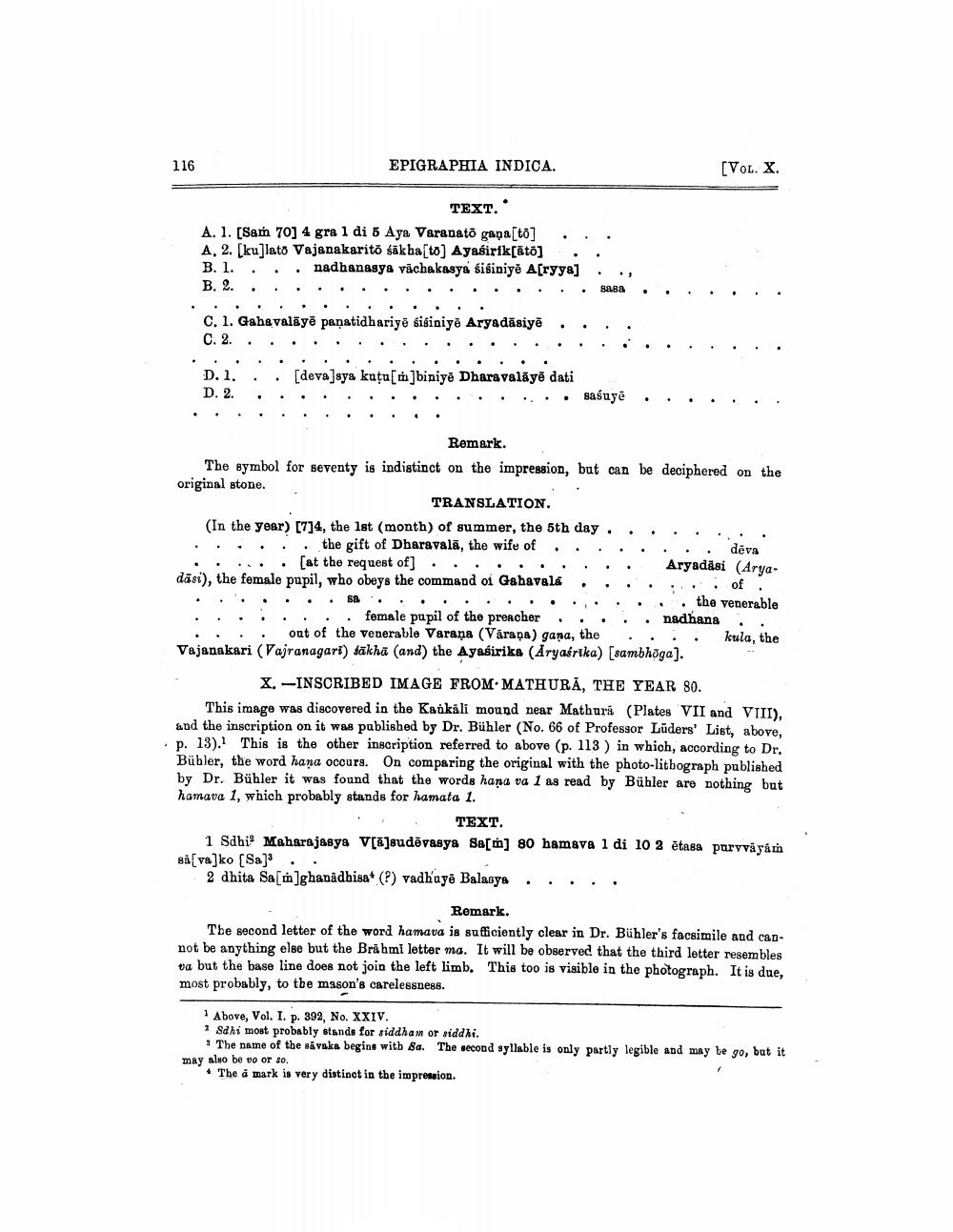________________
116
EPIGRAPHIA INDICA.
[Vol. X.
TEXT. A. 1. [Sam 70] 4 gra 1 di 5 Aya Varanato gana[to] . . . A. 2. [ku]lato Vajanakarito sākba[tb] Ayasirik[äto] . B. 1.. nadhanasya vācbakasya sisiniye A[ryya]. B. 2. . . . . . . . . . . . . . . . Sasa
.
.
.
.
.
.
.
C. 1. Gaha valāyē panatidhariye sisiniyə Aryadăsiye C. 2. . . . . . . . . . . . . . .
. .
. .
.
.
.
.
.
.
.
.
.
D.1..[deva]sya kuta[in]biniye Dharavalāyē dati D. 2. . . . . . . . . . . . . . . .
sasuye
.
.
.
.
... dēva
Remark The symbol for seventy is indistinct on the impression, but can be deciphered on the original stone.
TRANSLATION (In the year) [7]4, the 1st (month) of summer, the 5th day.
. . .the gift of Dharavalä, the wife of .. . .. ... . (at the request of] . . . .
Aryadāsi (Aryadāsi), the female pupil, who obeys the command of Gahavala . . . . of. .
.
. . .. the venerable . . . . . . . female pupil of the preacher ... . nadhana .
i. out of the venerable Varana (Váraņa) gana, the . . . . kula, the Vajanakari (Vajranagari) sakha (and) the Ayasirika (Aryafrika) (sambhoga). - X. --INSCRIBED IMAGE FROM MATHURĀ, THE YEAR 80.
This image was discovered in the Kaúkäli mound near Mathura (Plates VII and VIII). and the inscription on it was published by Dr. Bühler (No. 66 of Professor Lüders' List, above, . p. 13). This is the other inscription referred to above (p. 113 ) in which, according to Dr.
Bühler, the word hana occurs. On comparing the original with the photo-lithograph published by Dr. Bühler it was found that the words hana va 1 as read by Bühler are nothing but hamava 1, which probably stands for hamata 1.
TEXT. 1 Sdhi Maharajasya V[E]audēvasya Sa[m] 80 hamava 1 di 10 2 ētasa parvvåyår si(va]ko [Sal . .
2 dhita Sa[m]ghanādbisa() vadh'uya Balasya .....
Remark. The second letter of the word hamava is sufficiently clear in Dr. Bühler's facsimile and cannot be anything else but the Brahmi letter ma. It will be observed that the third letter resembles va but the base line does not join the left limb. This too is visible in the photograph. It is due, most probably, to the mason's carelessness.
Above, Vol. I. p. 392, No. XXIV. • Sdhi most probably stands for siddham or riddhi.
The name of the sávska begins with Sa. The second syllable is only partly legible and may be go, but it may also be eo or so.
• The á mark is very distinct in the impression.




